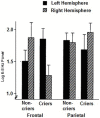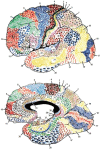Intentionality and "free-will" from a neurodevelopmental perspective
- PMID: 22754510
- PMCID: PMC3385506
- DOI: 10.3389/fnint.2012.00036
Intentionality and "free-will" from a neurodevelopmental perspective
Abstract
The nature of free-will as a subset of intentionality and probabilistic and deterministic function is explored with the indications being that human behavior is highly predictable which in turn, should compromise the notion of free-will. Data supports the notion that age relates to the ability to progressively effectively establish goals performed by fixed action patterns and that these FAPs produce outcomes that in turn modify choices (free-will) for which FAPs need to be employed. Early goals require behaviors that require greater automation in terms of FAPs that lead to goals being achieved or not; if not, then one can change behavior and that in turn is free-will. Goals change with age based on experience which is similar to the way in which movement functions. We hypothesize that human prefrontal cortex development was a natural expansion of the evolutionarily earlier developed areas of the frontal lobe and that goal-directed movements and behavior, including choice and free-will, provided for an expansion of those areas. The same regions of the human central nervous system that were already employed for better control, coordination, and timing of movements, expanded in parallel with the frontal cortex. The initial focus of the frontal lobes was the control of motor activity, but as the movements became more goal-directed, greater cognitive control over movement was necessitated leading to voluntary control of FAPs or free-will. The paper reviews the neurobiology, neurohistology, and electrophysiology of brain connectivities developmentally, along with the development of those brain functions linked to decision-making from a developmental viewpoint. The paper reviews the neurological development of the frontal lobes and inter-regional brain connectivities in the context of optimization of communication systems within the brain and nervous system and its relation to free-will.
Keywords: electrophysiology; fixed-action patterns; free-will; frontal-lobe; functional connection; goal direction; self-regulation.
Figures






Similar articles
-
The Brain in (Willed) Action: A Meta-Analytical Comparison of Imaging Studies on Motor Intentionality and Sense of Agency.Front Psychol. 2019 Apr 12;10:804. doi: 10.3389/fpsyg.2019.00804. eCollection 2019. Front Psychol. 2019. PMID: 31031676 Free PMC article.
-
Timing function of the frontal cortex in sequential motor and learning tasks.Hum Neurobiol. 1985;4(3):143-54. Hum Neurobiol. 1985. PMID: 4066425
-
The role of supplementary eye field in goal-directed behavior.J Physiol Paris. 2015 Feb-Jun;109(1-3):118-28. doi: 10.1016/j.jphysparis.2015.02.002. Epub 2015 Feb 23. J Physiol Paris. 2015. PMID: 25720602 Free PMC article. Review.
-
Developmental trajectories of the fronto-temporal lobes from infancy to early adulthood in healthy individuals.Dev Neurosci. 2012;34(6):477-87. doi: 10.1159/000345152. Epub 2012 Dec 21. Dev Neurosci. 2012. PMID: 23257954
-
Sequential memory: a developmental perspective on its relation to frontal lobe functioning.Neuropsychol Rev. 2004 Mar;14(1):43-64. doi: 10.1023/b:nerv.0000026648.94811.32. Neuropsychol Rev. 2004. PMID: 15260138 Review.
Cited by
-
Thinking, Walking, Talking: Integratory Motor and Cognitive Brain Function.Front Public Health. 2016 May 25;4:94. doi: 10.3389/fpubh.2016.00094. eCollection 2016. Front Public Health. 2016. PMID: 27252937 Free PMC article. Review.
-
Modeling intentionality in the human brain.Front Psychiatry. 2023 Aug 9;14:1163421. doi: 10.3389/fpsyt.2023.1163421. eCollection 2023. Front Psychiatry. 2023. PMID: 37621971 Free PMC article.
-
Increased [18F]Fluorodeoxyglucose Uptake in the Left Pallidum in Military Veterans with Blast-Related Mild Traumatic Brain Injury: Potential as an Imaging Biomarker and Mediation with Executive Dysfunction and Cognitive Impairment.J Neurotrauma. 2024 Jul;41(13-14):1578-1596. doi: 10.1089/neu.2023.0429. Epub 2024 May 8. J Neurotrauma. 2024. PMID: 38661540 Free PMC article.
-
QEEG spectral and coherence assessment of autistic children in three different experimental conditions.J Autism Dev Disord. 2015 Feb;45(2):406-24. doi: 10.1007/s10803-013-1909-5. J Autism Dev Disord. 2015. PMID: 24048514 Free PMC article.
-
Priority setting and personal health responsibility: an analysis of Norwegian key policy documents.J Med Ethics. 2022 Jan;48(1):39-45. doi: 10.1136/medethics-2019-105612. Epub 2020 Mar 2. J Med Ethics. 2022. PMID: 32122963 Free PMC article.
References
-
- Buck R. (1985). Prime theory: an integrated view of motivation and emotion. Psychol. Rev. 92, 389–413
-
- Buss A. H., Plomin R. (1975). A Temperament Theory of Personality Development. New York, NY: Wiley
-
- Buss A. H., Plomin R. (1986). “The EAS approach to temperament,” in The Study of Temperament: Changes, Continuities and Challenges Plomin, eds Plomin R., Dunn J. (Hillsdale, NJ: Lawrence Erlbaum; ), 67–77
LinkOut - more resources
Full Text Sources

